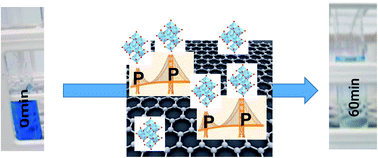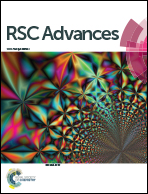Growth of binary anatase–rutile on phosphorylated graphene through strong P–O–Ti bonding affords a stable visible-light photocatalyst†
Abstract
Titanium dioxide is an ubiquitous photocatalyst in water-cleaning technologies, being presently the most promising tools to resolve the global issue of sewage treatment. In this framework, titanium dioxide–graphene nanocomposites are discussed as promising visible-light activated photocatalysts but little is hitherto known about the surface and interface chemistry bridging the metal oxide and carbon phases. In an attempt to spotlight this overlooked issue, we herein designed two different hybrid nanocomposites through covalent grafting and growth of titanium dioxide clusters on graphene oxide and on phosphorylated graphene oxide, which affords GO@TiO2 and PGO@TiO2, respectively. While anatase could be selectively harvested on the surface of GO@TiO2, biphasic anatase–rutile nucleates could be obtained on PGO@TiO2. Thermal annealing treatments improve the metal oxide crystallization and further remove oxygenated groups from the surface of graphene. The interfacial stability of these photocatalysts was also investigated under irradiation, with the graphene support being sensitive to the proximal presence of titanium dioxide. The resulting nanocomposites were also assessed for methylene blue removal through adsorption and photocatalysis. Regardless of their composition, superior photoactivity was noticed for the nanocomposites compared to commercially available degussa that display marginal visible-light photoactivity (11% removal). Within our study, PGO@TiO2-500 stands as the most active catalyst, allowing nearly quantitative removal of the pollutant from water. The superior performance of PGO@TiO2-500 can be explained by the highest stability reached through P–O–Ti bonding, its improved crystallinity, and the reduction of the graphene surface during thermal treatment. On a whole, this study provides a blueprint for comparing semiconducting metal oxide grown on tuneable surface-interfacial graphene environments and highlights the utility of surface-engineering graphene sheets to access efficient visible-light oxidation photocatalysts.



 Please wait while we load your content...
Please wait while we load your content...